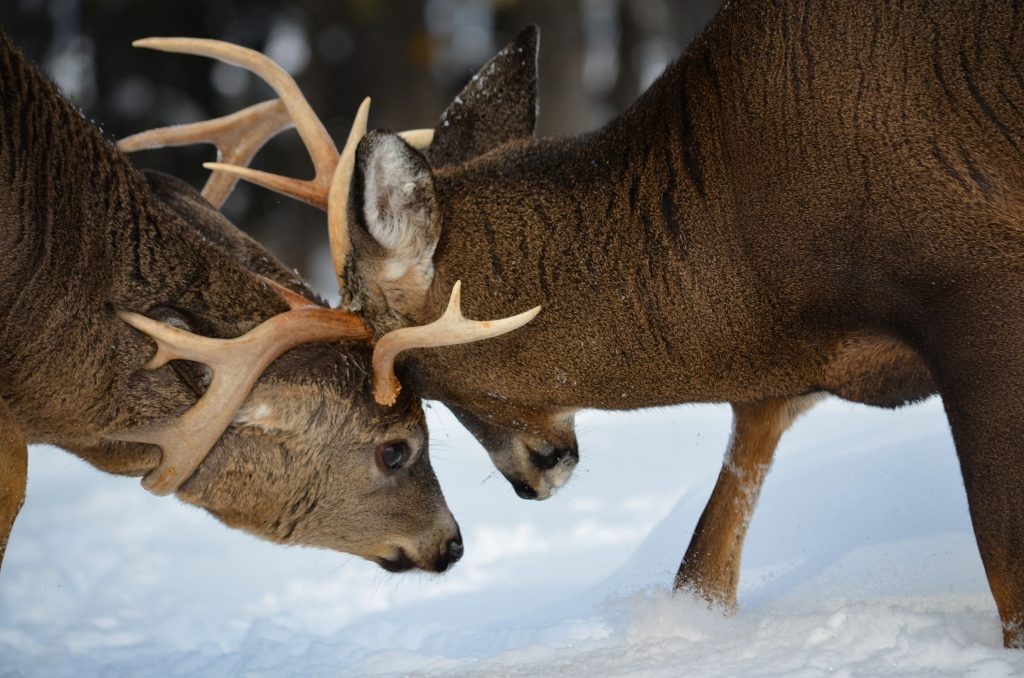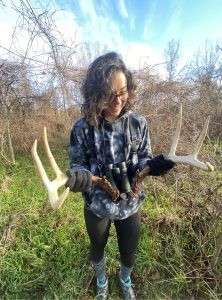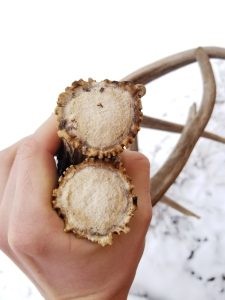Are you intrigued by the fascinating world of deer antlers and curious about the process of antler shedding? At WHY.EDU.VN, we provide clear explanations and in-depth knowledge to satisfy your quest for understanding. Delve into the details of why deer shed their antlers, the biological mechanisms involved, and the factors that influence this natural phenomenon, while exploring related topics such as antler growth, hormonal regulation, and deer behavior.
1. The Purpose of Antlers: More Than Just Decoration
Antlers, unlike horns, are unique bony structures that deer grow and shed annually. But why do they go through this energy-intensive process?
1.1. Distinguishing Antlers from Horns
| Feature | Antlers | Horns |
|---|---|---|
| Composition | Bone | Bone core with keratin sheath |
| Shedding | Shed annually | Not shed (except for pronghorn) |
| Branching | Typically branched or forked | Usually not forked |
| Growth | Grow from the tips while in velvet | Grow from the base |



1.2. Antlers as Indicators of Health and Fitness
Antlers serve as a visual indicator of a buck’s health, genetic quality, and social status. Larger, well-formed antlers often signal a robust and healthy individual, making them attractive to potential mates.
- Mate Selection: Does often choose to mate with bucks possessing larger antlers, increasing the likelihood of healthy offspring.
- Sparring and Dominance: Antlers are used in sparring matches to establish dominance, which directly impacts breeding opportunities and survival.
- Health Indicator: Antler size and quality reflect a buck’s nutritional status and overall health. A buck with injuries or poor nutrition will likely have smaller or deformed antlers.
1.3. The Energy Cost of Antler Growth
Growing antlers requires significant energy and mineral resources. During the growth phase, bucks experience a temporary state of osteoporosis as their bodies mobilize calcium and phosphorus from their skeleton to support rapid antler development.
2. The Hormonal Symphony: Testosterone’s Role
Testosterone is the primary hormone regulating antler growth, mineralization, and shedding. Fluctuations in testosterone levels, influenced by photoperiod and other factors, orchestrate the entire antler cycle.
2.1. Rising Testosterone Levels: The Signal for Growth
In the spring and summer, as daylight hours increase, testosterone levels rise, stimulating antler growth. This phase is characterized by the “velvet” stage, where antlers are covered in a soft, vascularized tissue that supplies nutrients.
2.2. Peak Testosterone: Hardening and the Rut
As testosterone levels peak in the fall, antlers mineralize and the velvet dries and sheds. This coincides with the breeding season, or rut, during which bucks exhibit increased aggression and focus on mating.
2.3. Declining Testosterone: The Trigger for Shedding
After the rut, testosterone levels decline due to decreasing daylight hours. This decline triggers the activation of osteoclasts, specialized cells that break down bone tissue at the base of the antlers.
3. The Abscission Zone: Where Antlers Detach
The shedding process occurs at a specific location called the abscission zone, located between the antler base (burr) and the pedicle (bony projection on the skull).
3.1. Osteoclast Activity
Osteoclasts resorb bone tissue within the abscission zone, weakening the connection between the antler and the pedicle.
3.2. Weakening and Shedding
As the abscission zone weakens, the antlers eventually detach, leaving a pitted surface at the base of the shed antler. The pedicle is then covered with a scab, and the process begins anew the following spring.
3.3. Factors Affecting Shedding Time
- Photoperiod: The primary driver of antler shedding is day length. Shorter days lead to decreased testosterone levels.
- Health and Nutrition: Healthy bucks in good condition tend to shed later than those in poor condition.
- Injury and Stress: Injury or stress can cause a premature drop in testosterone, leading to early shedding.
- Late Breeding: If breeding opportunities persist later in the season, bucks may maintain higher testosterone levels, delaying shedding.
4. Environmental Cues: The Sun’s Influence
Photoperiod, or day length, is the most critical environmental cue regulating the antler cycle. Deer have evolved to respond to seasonal changes in daylight, ensuring that antler growth and shedding are synchronized with the breeding season and resource availability.
4.1. The Role of the Pineal Gland
The pineal gland, located in the brain, is responsible for producing melatonin, a hormone that regulates circadian rhythms and seasonal changes. Photoperiod influences melatonin production, which in turn affects testosterone levels and the antler cycle.
4.2. Latitude and Shedding Time
Deer living in different latitudes may experience variations in shedding time due to differences in day length patterns.
5. The Consequences of Early or Late Shedding
Abnormal shedding patterns can indicate underlying health issues or environmental stressors.
5.1. Early Shedding
Early shedding may indicate poor nutrition, injury, or disease. Bucks that shed early may be less competitive during the breeding season and may have reduced reproductive success.
5.2. Late Shedding
Late shedding can sometimes occur in healthy, dominant bucks or in areas with late breeding opportunities. However, it can also indicate hormonal imbalances or other health problems.
6. Why Antlers and Not Horns? An Evolutionary Perspective
The question of why deer evolved to grow and shed antlers annually, rather than possessing permanent horns, is a subject of ongoing scientific inquiry.
6.1. A More Sensitive Indicator of Fitness
Antlers may provide a more sensitive indication of a buck’s health and genetic quality than horns. The annual growth cycle allows antlers to reflect current nutritional status and environmental conditions, providing does with up-to-date information about potential mates.
6.2. Regrowth After Damage
Antlers can be regrown each year, even if damaged during sparring. Horns, on the other hand, cannot be regrown if broken.
6.3. Energy Investment
While growing antlers requires significant energy, the annual cycle may allow deer to optimize energy allocation based on seasonal changes and resource availability.
7. Finding Shed Antlers: A Popular Pursuit
Shed hunting has become an increasingly popular outdoor activity, allowing enthusiasts to explore nature, observe deer behavior, and collect unique trophies.
7.1. Tips for Shed Hunting
- Timing: Shed hunting is best done in late winter and early spring, after most bucks have shed their antlers.
- Location: Focus on areas where deer congregate, such as feeding areas, bedding areas, and travel corridors.
- Technique: Walk slowly and scan the ground carefully, paying attention to areas with thick cover or uneven terrain.
- Respect: Obtain permission from landowners before entering private property, and avoid disturbing wildlife.
7.2. The Ethics of Shed Hunting
It is important to practice ethical shed hunting by minimizing disturbance to wildlife and respecting private property rights.
8. The Future of Antler Research
Ongoing research continues to shed light on the complex processes underlying antler growth and shedding.
8.1. Genetic Studies
Genetic studies are helping to identify the genes that influence antler size, shape, and growth rate.
8.2. Hormonal Research
Hormonal research is exploring the intricate interactions between testosterone, other hormones, and environmental factors in regulating the antler cycle.
8.3. Nutritional Studies
Nutritional studies are investigating the role of diet and mineral supplementation in antler development.
9. The Intricate Beauty of Nature’s Design
Deer antlers are a testament to the intricate beauty and complexity of nature’s design. They serve as visual indicators of health, status, and genetic quality, playing a crucial role in deer reproduction and survival. Understanding the antler cycle provides valuable insights into the biology and ecology of these magnificent animals.
10. Expert Insights from WHY.EDU.VN
At WHY.EDU.VN, we strive to provide accurate, reliable, and engaging information about the natural world. Our team of experts is dedicated to answering your questions and helping you deepen your understanding of the fascinating phenomena that shape our planet.
10.1. Connect With Us
Do you have more questions about deer antlers or other topics related to wildlife biology? Visit our website at WHY.EDU.VN to explore our extensive collection of articles, videos, and interactive resources. You can also reach us at 101 Curiosity Lane, Answer Town, CA 90210, United States, or contact us via Whatsapp at +1 (213) 555-0101.
10.2. Your Questions Answered
We understand that finding reliable answers to your questions can be challenging. That’s why we’ve created WHY.EDU.VN as a platform where you can easily access expert knowledge and find the solutions you need.
11. Call to Action
Still curious? Dive deeper into the world of deer and antler biology! Visit WHY.EDU.VN today to ask your questions and discover a wealth of knowledge from our experts. Let us help you understand the wonders of the natural world.
12. Frequently Asked Questions (FAQs)
Here are some frequently asked questions about deer antlers and the shedding process:
| Question | Answer |
|---|---|
| 1. What are antlers made of? | Antlers are made of bone, primarily calcium and phosphorus. |
| 2. How fast do antlers grow? | Antlers are the fastest-growing tissue in the animal kingdom, capable of growing several inches per day during peak growth. |
| 3. Do all deer species shed their antlers? | No, only male deer (bucks) in most deer species shed their antlers. Female reindeer (caribou) also grow and shed antlers. |
| 4. Do shed antlers regrow in the same shape? | Antlers typically regrow in a similar shape each year, but there can be variations due to genetics, nutrition, and injury. |
| 5. What is antler velvet? | Antler velvet is the soft, vascularized tissue that covers growing antlers, providing nutrients and oxygen to the developing bone. |
| 6. What causes bucks to rub their antlers? | Bucks rub their antlers to remove the velvet, polish the bone, and mark their territory with scent from glands on their forehead. |
| 7. Can you determine a buck’s age from its antlers? | Antler size and configuration can provide clues about a buck’s age, but it is not an exact science. Other factors, such as nutrition and genetics, also play a role. |
| 8. What is the purpose of the burr at the base of an antler? | The burr is a protective shield at the base of the antler, protecting the skin edge where the antler meets the pedicle. |
| 9. How do osteoclasts contribute to antler shedding? | Osteoclasts are specialized cells that break down bone tissue at the abscission zone, weakening the connection between the antler and the pedicle, ultimately leading to shedding. |
| 10. Are shed antlers valuable? | Shed antlers can be valuable for various purposes, including dog chews, crafts, and collectibles. They are also a renewable resource, as they are naturally shed each year. |
13. Navigating the World of Deer Biology
Understanding the science behind antler shedding can deepen your appreciation for deer and their fascinating adaptations.
14. Exploring Deer Behavior and Ecology
The shedding of antlers is just one aspect of the complex lives of deer. By exploring their behavior, ecology, and interactions with their environment, we can gain a more complete understanding of these remarkable animals.
15. Continuing the Journey of Discovery
At WHY.EDU.VN, we are committed to providing you with the knowledge and resources you need to continue your journey of discovery. Whether you are a student, a researcher, or simply a curious individual, we invite you to join us in exploring the wonders of the natural world.
16. The Importance of Reliable Information
In an age of information overload, it can be challenging to distinguish between credible sources and misinformation. WHY.EDU.VN is dedicated to providing accurate, evidence-based information that you can trust.
17. Unveiling Nature’s Secrets
From the smallest microorganisms to the largest mammals, the natural world is full of secrets waiting to be unveiled. By asking questions, seeking answers, and sharing our knowledge, we can deepen our understanding of the planet and our place within it.
18. The Cycle of Life
The shedding of antlers is a reminder of the cyclical nature of life. As antlers are shed and regrown each year, deer adapt to changing environmental conditions and continue to thrive in their habitats.
19. Join the WHY.EDU.VN Community
Connect with other curious minds and share your passion for learning. At WHY.EDU.VN, we believe that knowledge is best when it is shared and that everyone has something to contribute to the conversation.
20. Expert Insights at Your Fingertips
Gain access to expert insights and in-depth explanations of complex topics. Our team of experts is dedicated to providing you with the knowledge you need to succeed in your studies, your career, and your personal life.
21. A Resource for All Learners
Whether you are a student, a teacher, or a lifelong learner, WHY.EDU.VN is a valuable resource for expanding your knowledge and understanding of the world.
22. Embracing Curiosity
At WHY.EDU.VN, we believe that curiosity is the driving force behind all great discoveries. We encourage you to embrace your curiosity, ask questions, and never stop learning.
23. Your Source for Answers
From science and technology to history and culture, WHY.EDU.VN is your go-to source for answers to your most pressing questions.
24. Unlock Your Potential
By expanding your knowledge and understanding of the world, you can unlock your full potential and achieve your goals. Let WHY.EDU.VN be your guide on the path to success.
25. The Beauty of Natural Processes
The antler shedding process is a beautiful example of the intricate and interconnected processes that shape the natural world. By understanding these processes, we can gain a deeper appreciation for the complexity and fragility of our planet.
26. Understanding Wildlife Dynamics
Understanding why deer shed their antlers helps us to appreciate the dynamics of wildlife populations and their adaptations to their environments. This knowledge is essential for effective conservation efforts and sustainable management practices.
27. The Broader Ecological Context
The antler cycle is not an isolated event but is interconnected with the broader ecological context, including habitat quality, food availability, and predator-prey relationships.
28. The Importance of Ecosystem Health
Maintaining healthy ecosystems is essential for supporting thriving deer populations and ensuring the continuation of natural processes like antler shedding.
29. Conservation and Management
Effective conservation and management strategies are crucial for protecting deer populations and their habitats, ensuring that future generations can continue to marvel at the beauty of antlered bucks.
30. Empowering Informed Decisions
By providing accurate and reliable information, WHY.EDU.VN empowers individuals to make informed decisions about conservation, management, and our relationship with the natural world.
31. The Interplay of Nature and Science
The study of antler shedding is an example of the interplay between nature and science, where scientific inquiry helps us to understand and appreciate the natural world.
32. Continuing the Legacy of Discovery
We invite you to join us in continuing the legacy of discovery by exploring the wonders of the natural world and sharing your knowledge with others.
33. A World of Knowledge Awaits
At WHY.EDU.VN, a world of knowledge awaits you. Explore our extensive collection of articles, videos, and interactive resources and discover the answers to your most pressing questions.
34. Connecting With Experts
Connect with experts in various fields and gain access to cutting-edge research and insights. Our team of experts is dedicated to providing you with the knowledge you need to succeed.
35. The Power of Education
Education is the key to unlocking human potential and solving the world’s most pressing challenges. At WHY.EDU.VN, we are committed to providing access to quality education for all.
36. Embracing Lifelong Learning
We encourage you to embrace lifelong learning and continue to expand your knowledge and understanding of the world.
37. Navigating the Information Age
In the information age, it is more important than ever to have access to reliable and accurate information. WHY.EDU.VN is your trusted source for expert knowledge and insights.
38. Your Trusted Resource
Trust WHY.EDU.VN to provide you with the answers you need and to guide you on your journey of discovery.
39. Contact Us Today
Have questions or need assistance? Contact us today at 101 Curiosity Lane, Answer Town, CA 90210, United States, or via Whatsapp at +1 (213) 555-0101. Visit our website at WHY.EDU.VN to learn more.
40. Discover More at WHY.EDU.VN
Unlock a world of knowledge and discover the answers to your questions at why.edu.vn. Join our community of curious learners and explore the wonders of the natural world.